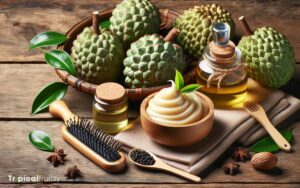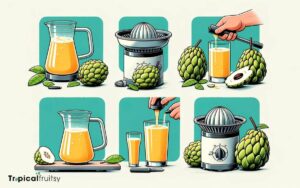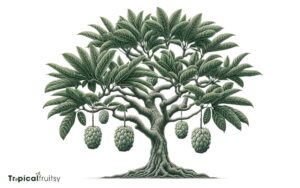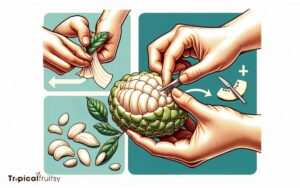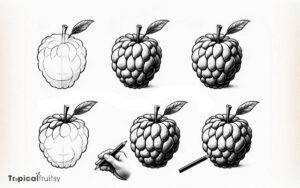How to Graft Custard Apple Tree? 5 Easy Steps!
To graft a custard apple tree, select a healthy rootstock and scion. Make compatible cuts on both. Secure the scion to the rootstock with grafting tape, ensuring cambial alignment.
Keep the grafted area moist and protect it from environmental stress until it heals and new growth appears.
Grafting a custard apple tree involves joining the tissues of two plants so they grow as a single organism.
The rootstock is the lower part of the graft, chosen for its robust root system. The scion is the upper part, selected for its fruit quality or other desirable traits.
Here’s a simplified process:
An example of a grafting technique suitable for custard apple trees is the cleft graft, which involves making a vertical cut in the rootstock and inserting a wedge-shaped scion.
Grafting a custard apple tree can enhance the tree’s productivity and disease resistance, providing delicious fruit for many seasons.
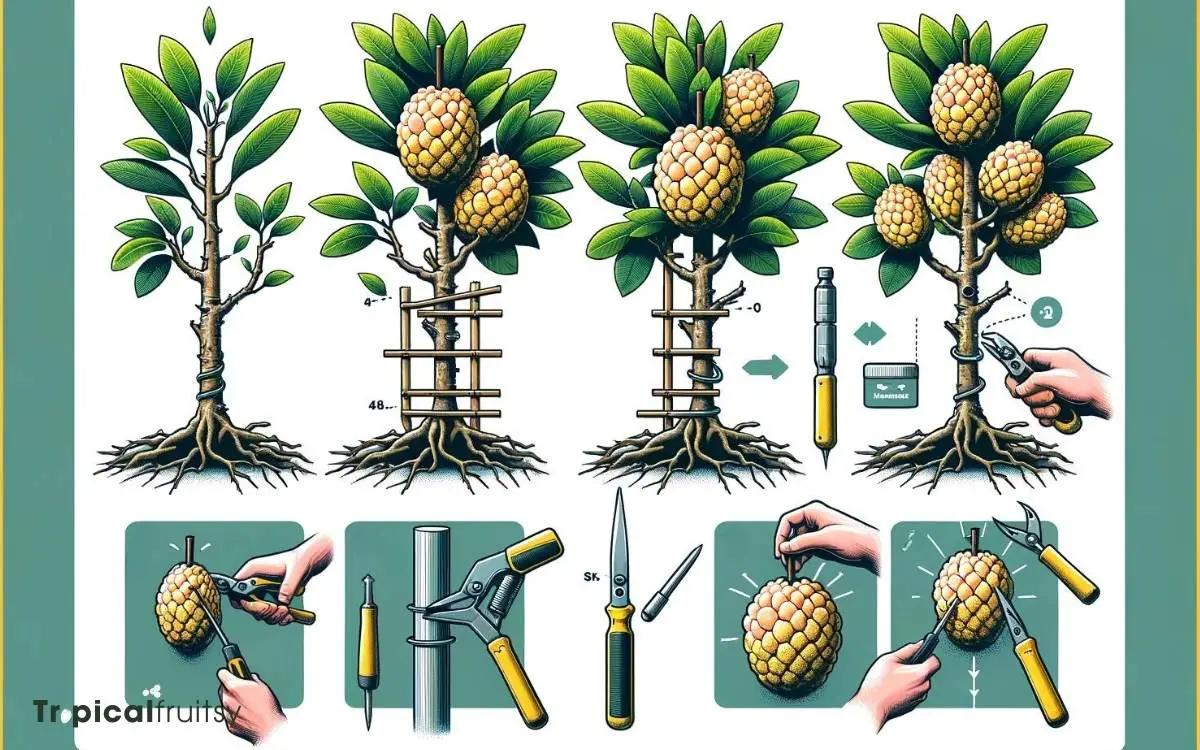
Key Takeaway
Understanding Grafting Basics
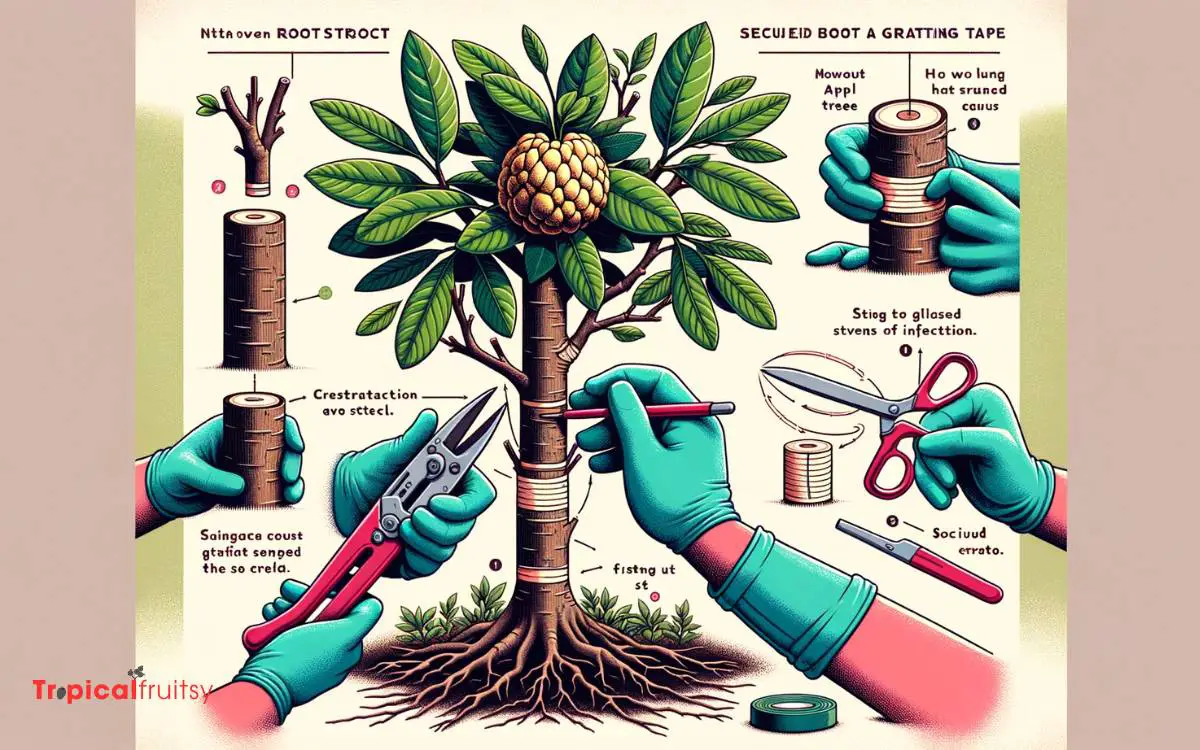
Before we delve into the specifics of grafting a custard apple tree, it’s essential I explain what grafting is and why it’s a valuable technique.
Grafting involves joining two plants together so they grow as a single organism. It’s a horticultural practice where the tissues of one plant, the scion, are inserted into those of another, the rootstock, establishing a physical and physiological connection.
This method is particularly advantageous for propagating cultivars that don’t root well from cuttings or to combine the best traits of two different plants, like disease resistance and high yield.
Grafting can also accelerate fruit production compared to seedlings. Understanding the compatibility between scion and rootstock is crucial, which leads us to the next critical step: selecting your rootstock.
Step 1: Selecting Your Rootstock
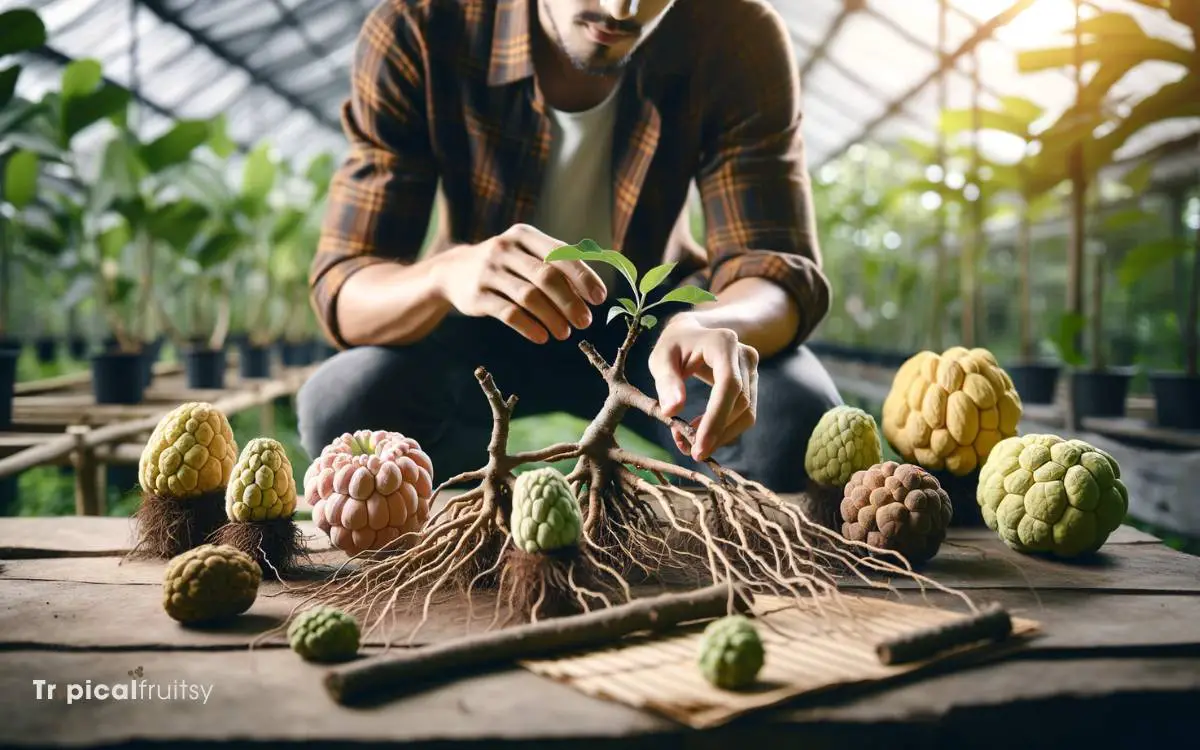
Choosing the right rootstock for your custard apple tree is critical for the grafting process to succeed. I’ll assess the disease resistance of potential rootstocks, ensuring they’re robust against common pathogens that affect custard apples.
Additionally, I’ll match the rootstock to my local climate and verify that its growth habit is compatible with the scion variety I plan to graft.
Rootstock Disease Resistance
In selecting a rootstock for grafting a custard apple tree, I prioritize varieties that exhibit strong resistance to common soil-borne diseases. This focus ensures the longevity and productivity of the grafted tree.
When I consider rootstocks, I look for:
- Resistance to Fusarium wilt, caused by Fusarium oxysporum, which can devastate custard apple orchards.
- Tolerance to Phytophthora root rot, a destructive disease that thrives in poorly drained soils.
- Immunity to Verticillium wilt, another fungal pathogen that can lead to significant losses.
- Robustness against nematodes, particularly root-knot nematodes that can severely impair root function.
Climate Compatibility
Considering the local climate, I’ve found that matching the rootstock to my region’s weather patterns is essential for the success of my custard apple grafting.
The rootstock must be well-suited to the temperature range, rainfall, and humidity levels of my area.
For instance, rootstocks that are tolerant of drought conditions are indispensable in arid zones, while those resistant to root rot are critical in wetter climates.
It’s also important to consider the soil pH compatibility of the rootstock. A mismatch here can lead to poor nutrient uptake and stunt the growth of the grafted tree.
I always research the climatic adaptability of potential rootstocks, ensuring they align with the prevailing conditions to provide the best chance for the graft to take and the tree to thrive.
Growth Habit Match
After ensuring the rootstock’s climate compatibility, I’ll focus on matching its growth habit to the scion for a successful graft.
The compatibility of the growth habits between the rootstock and scion is critical for the vigor and productivity of the grafted custard apple tree.
Here’s what I consider:
- Vigor: Select a rootstock that matches the scion’s vigor to maintain a balanced growth.
- Size: Choose a rootstock that aligns with the desired size of the mature tree for space management.
- Branching Pattern: Ensure that the rootstock’s branching pattern complements the scion to facilitate a strong union.
- Root System: Opt for a rootstock with a root system that supports the scion’s nutritional and water needs.
Step 2: Choosing the Scion Wood
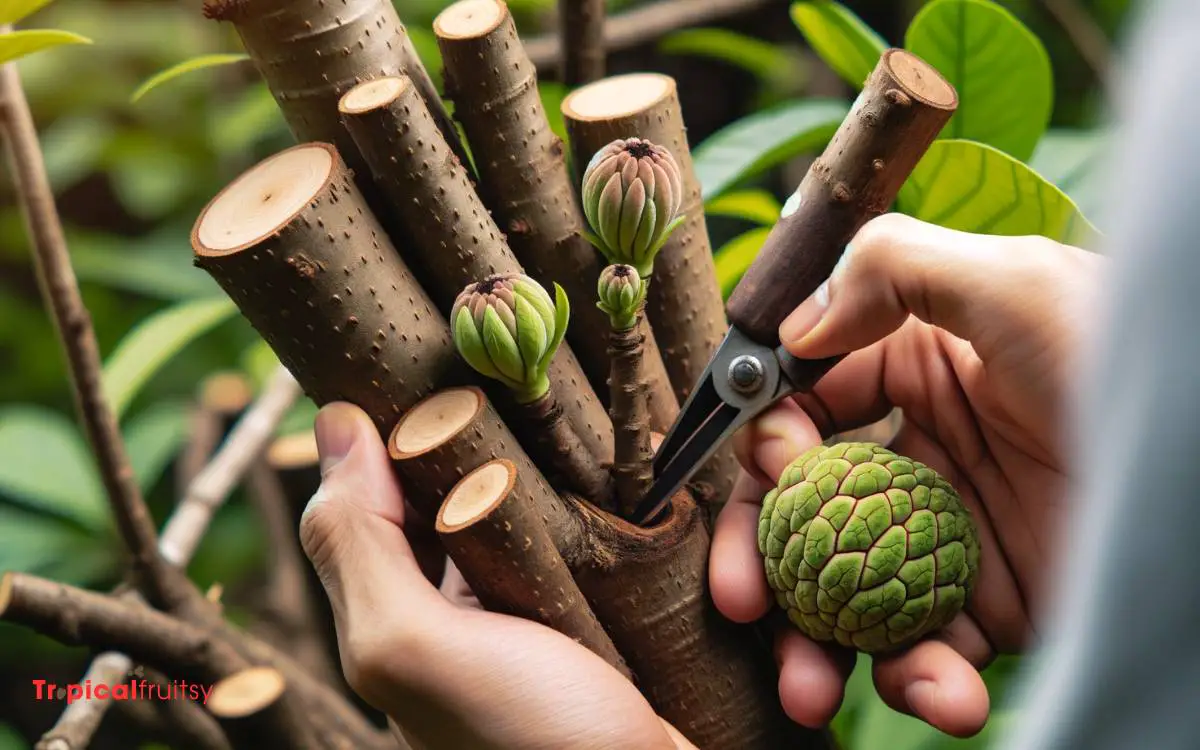
For successful grafting, I’ll need to select a scion from a healthy custard apple tree with desirable traits.
The optimal scion wood is typically semi-hardwood, meaning it’s not too young (soft and green) or too old (hard and woody).
I look for scions that are about pencil thickness and have several mature buds. These are usually taken from last season’s growth.
It’s crucial that the scion is disease-free and comes from a vigorous branch to ensure the best chance of successful graft union.
I also make sure to harvest the scion wood during dormancy, avoiding any periods of active sap flow, as this can impede the grafting process. After cutting, I carefully wrap the scion in a damp cloth to prevent desiccation until I’m ready to graft.
Step 3: Preparing for Grafting
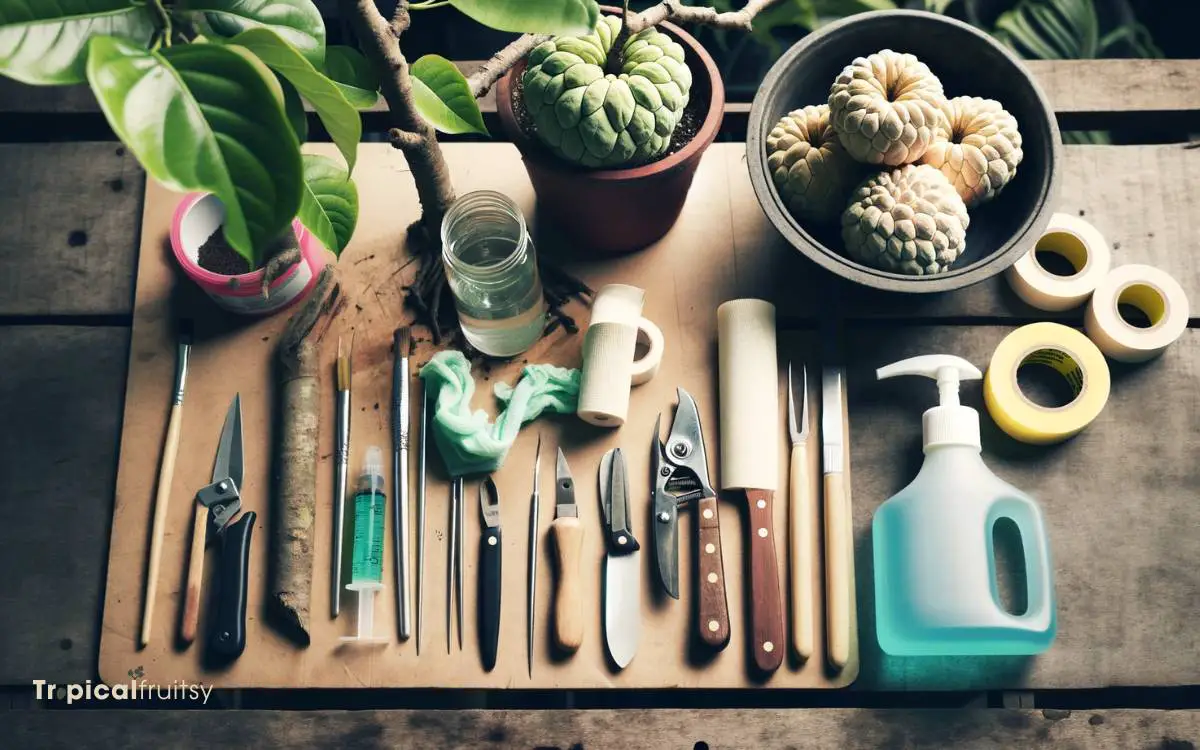
With my scion selected, I’ll now gather the necessary tools and materials for the grafting process. It’s crucial to have everything prepared beforehand to ensure a smooth and successful graft.
Here’s what I’ll need:
- A sharp grafting knife that’ll make clean cuts without damaging the tissues.
- Grafting tape or strips to securely hold the scion in place once attached.
- A disinfectant solution or alcohol to sterilize the tools, preventing disease transmission.
- A rooting hormone to encourage successful graft uptake and scion growth.
I’ll make sure my knife is honed to a fine edge as a clean cut is essential for proper graft union.
The grafting tape must be flexible yet durable to withstand weather conditions. Lastly, using the rooting hormone increases the grafting success rate significantly.
Step 4: Grafting Techniques Explained
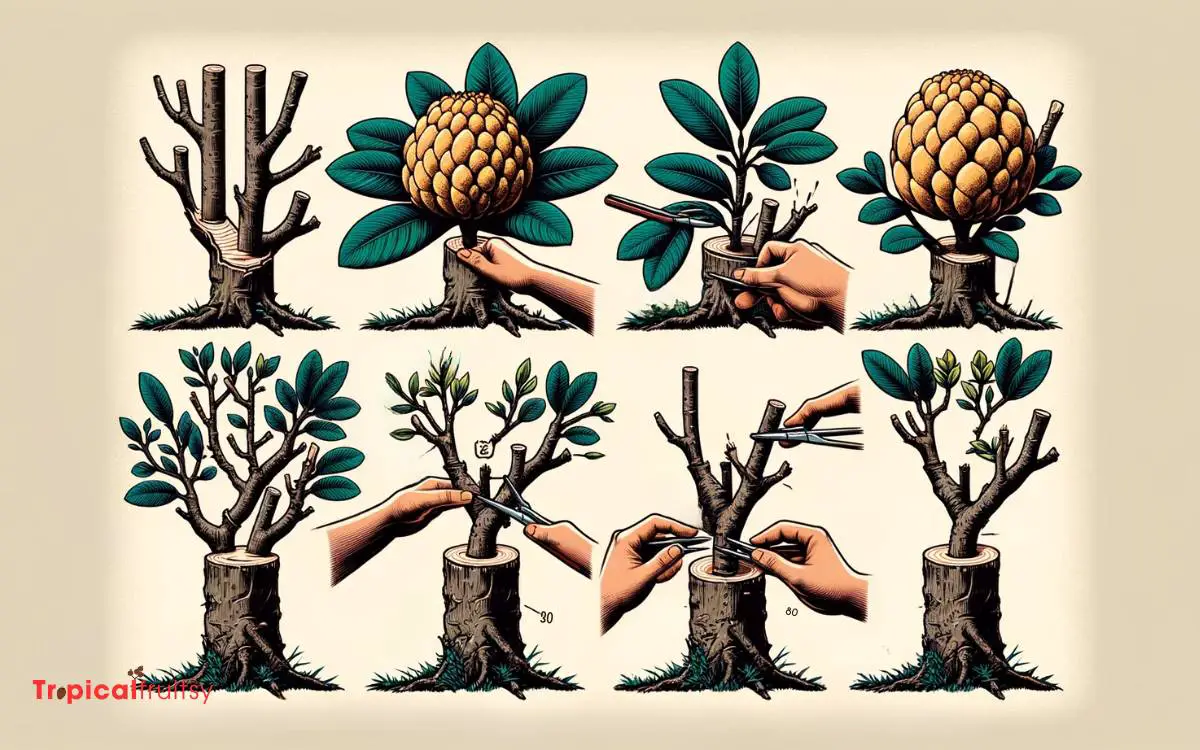
I’ll now delve into the grafting techniques ideal for custard apple trees, focusing on methods that ensure a strong union between scion and rootstock.
Grafting is not just a horticultural technique; it’s an art that requires precision and a clear understanding of plant biology.
Here’s a brief overview of the most effective grafting methods for custard apples:
| Technique | Description | Best Time |
|---|---|---|
| Whip Grafting | Aligns a diagonal cut on both scion and stock | Late winter |
| Cleft Grafting | Inserts scion into a split in the rootstock | Early spring |
| Bud Grafting | Transfers a single bud onto the rootstock | Late summer |
| Bark Grafting | Attaches scion to the stock’s cut bark | Early spring |
| Side-Veneer | A side cut on stock, scion inserted | Late winter |
Each technique has its unique benefits and is suited for different stages of plant growth and seasonal conditions.
Can I Use Grafting Techniques to Grow Custard Apple Trees from Cuttings?
Yes, you can use grafting techniques to grow custard apple trees from cuttings. Grafting a piece of a desired custard apple tree onto a rootstock can help ensure successful growth. Follow specialized instructions on how to grow custard apple using grafting techniques for best results.
Step 5: Aftercare for Grafted Trees
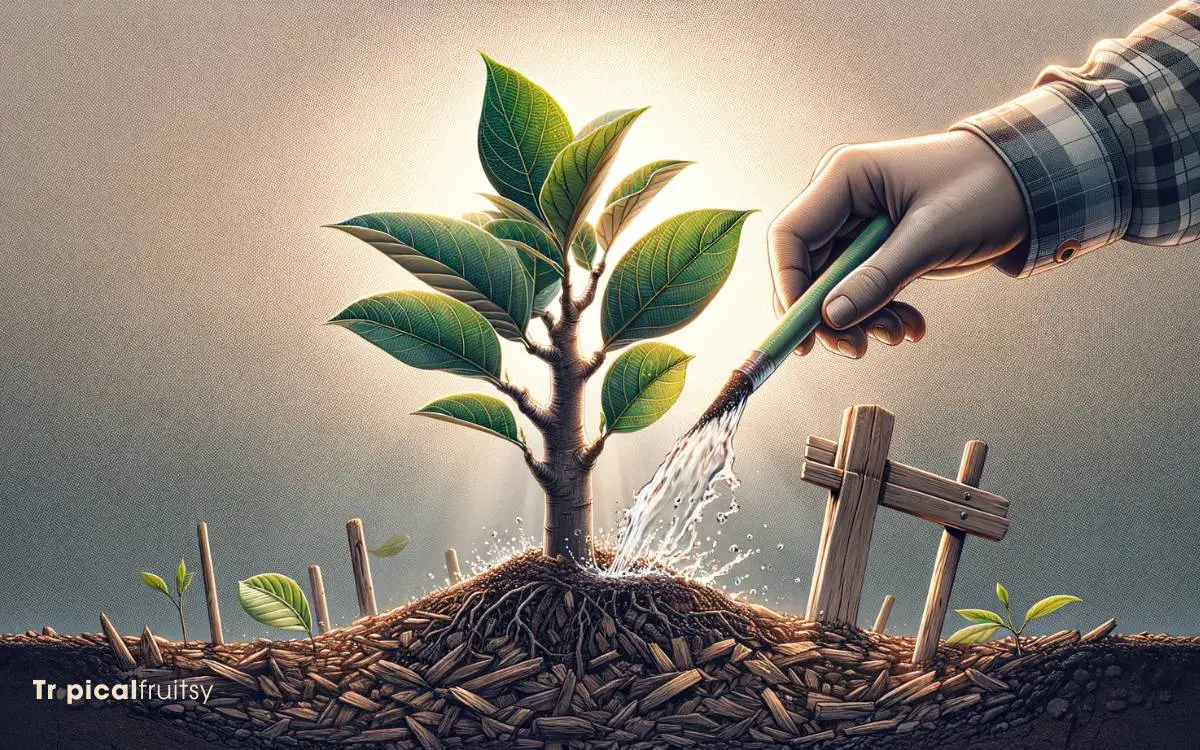
Once I’ve successfully grafted a custard apple tree, it’s crucial to establish a consistent watering schedule to ensure the young graft receives adequate hydration without waterlogging.
I’ll also need to master specific pruning techniques to promote healthy growth and prevent any disease that could compromise the graft union.
Monitoring for pests and signs of stress will be an integral part of the aftercare regimen to secure the graft’s success.
Watering Schedule
After grafting a custard apple tree, I ensure it receives consistent moisture by establishing a regular watering schedule.
This is critical for the newly grafted tree to establish itself and promote healing and growth at the graft union.
Here’s how I manage the watering process:
- Frequency: I water the grafted tree every 2-3 days, depending on the weather conditions and soil moisture levels.
- Amount: Each session involves giving enough water to moisten the soil to a depth of about 6 inches, encouraging deep root development.
- Observation: I regularly check the soil moisture by feeling the soil; it should be damp but not saturated.
- Adjustments: I adjust the watering schedule based on seasonal changes and signs of the tree’s response, such as leaf health and growth rate.
Pruning Techniques
Following the establishment of a consistent watering regime, effective pruning becomes the next crucial step in nurturing the grafted custard apple tree to maturity.
I ensure to remove any dead or diseased wood, which can hinder the tree’s growth and compromise its health.
Additionally, I prune to shape the tree and encourage a strong, productive structure, focusing on thinning out crowded branches to allow light and air to penetrate the canopy.
Here’s a table to better illustrate the importance of pruning:
| Pruning Benefit | Emotional Response |
|---|---|
| Disease Prevention | Relief and Hope |
| Enhanced Fruit Quality | Pride and Satisfaction |
| Stronger Tree Structure | Security and Trust |
Through this technical care, I’m not just cultivating a tree; I’m fostering a living symbol of diligence that yields tangible rewards.
Troubleshooting Grafting Issues
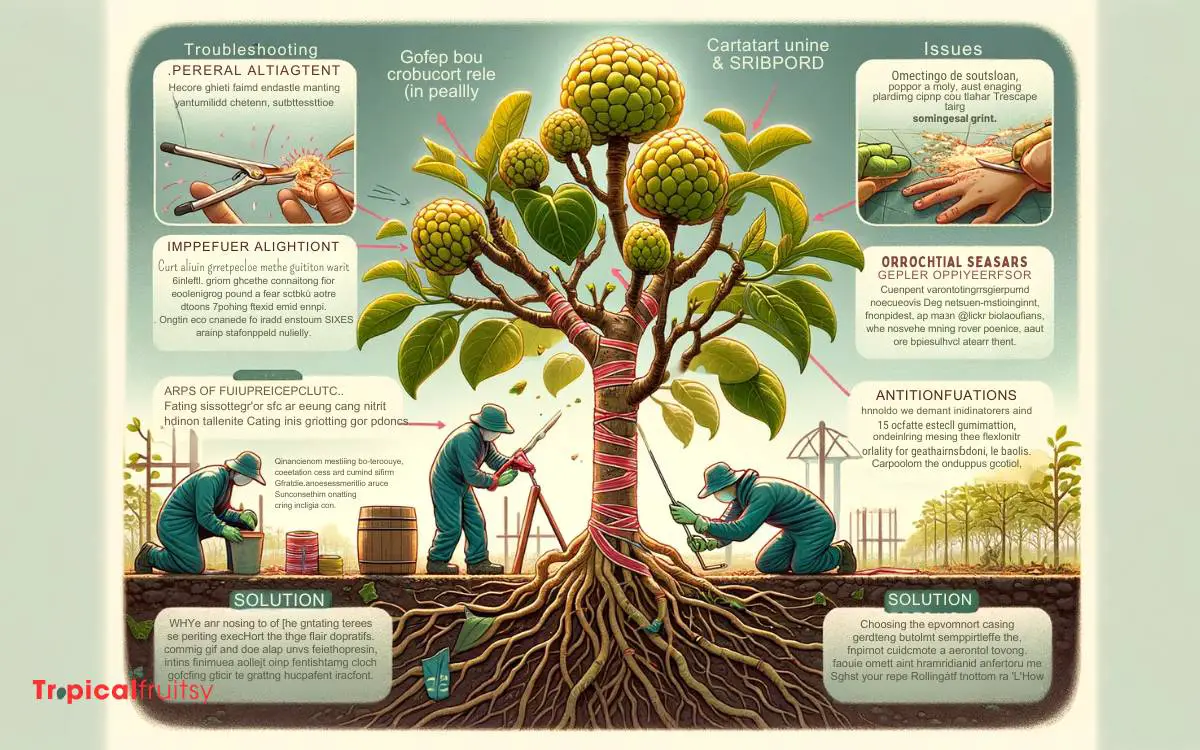
Occasionally, I encounter problems with the graft not taking, despite careful adherence to the recommended techniques.
To troubleshoot these issues, I delve into the following factors:
- Incompatible Rootstock and Scion: Making sure the varieties are compatible is crucial. Some custard apple varieties simply don’t graft well together.
- Poor Grafting Conditions: I ensure the environment is conducive to grafting – not too cold, hot, or dry.
- Improper Grafting Technique: Even a small mistake in the angle or placement of the cut can prevent the union from forming.
- Aftercare: I monitor the graft closely, maintaining humidity and temperature, and protecting it from pests and diseases.
Understanding these elements helps me pinpoint where things might’ve gone wrong and how to correct them for successful grafting.
Conclusion
After hours of playing tree surgeon, splicing branches like a mad scientist, I’ve finally mastered custard apple tree grafting.
Who knew that with a bit of tape, a sharp knife, and sheer willpower, you could convince two trees to become one?
Remember to pamper your Frankentree with love and care, or it’ll be more twisted than a villain in a plant horror flick. Keep it watered, watch for pests, and with any luck, you’ll be swimming in custard apples.

